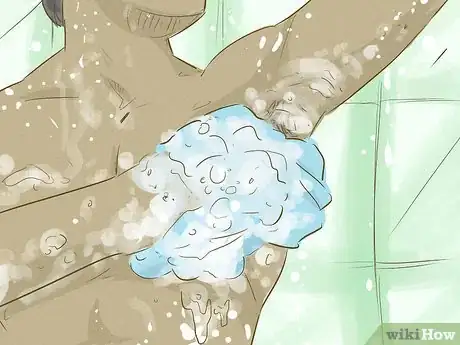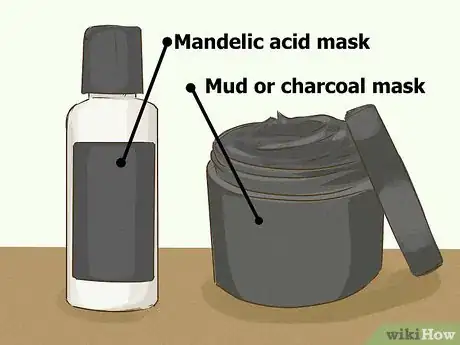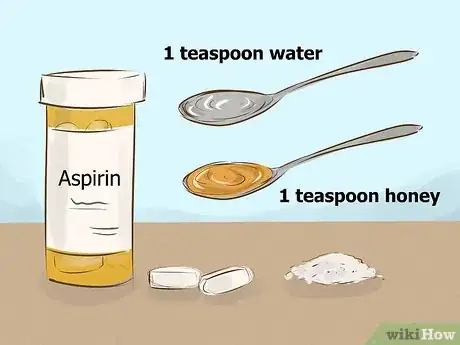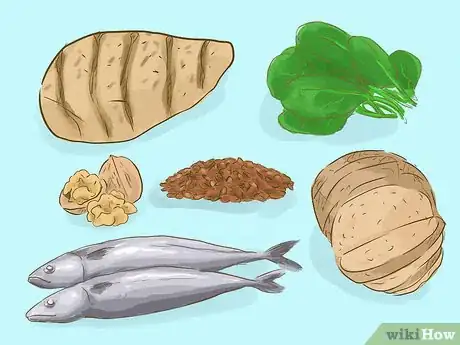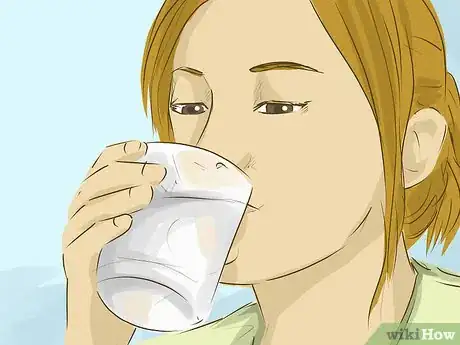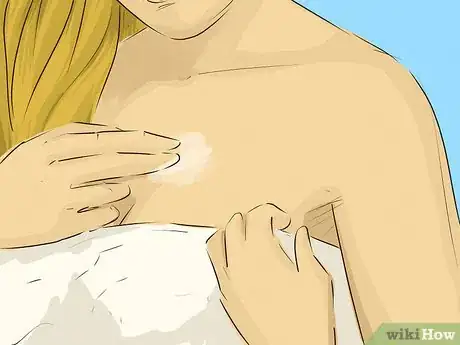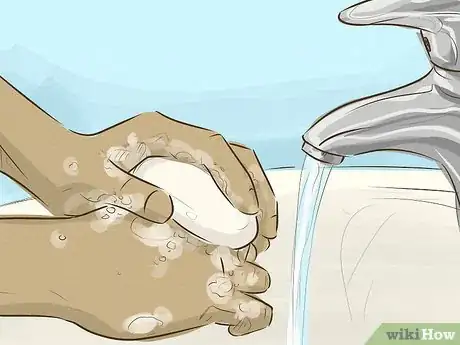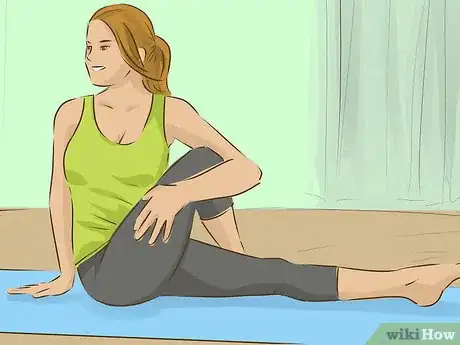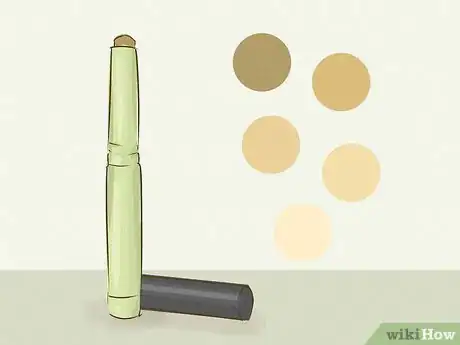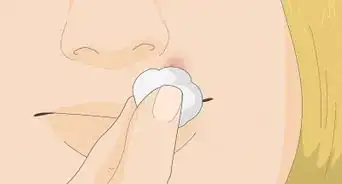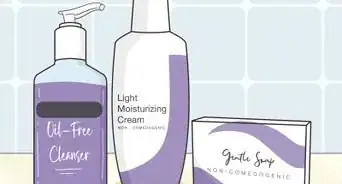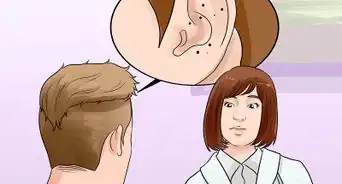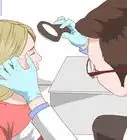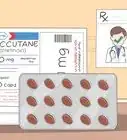This article was co-authored by Kimberly Tan. Kimberly Tan is the Founder & CEO of Skin Salvation, an acne clinic in San Francisco. She has been a licensed esthetician for over 15 years and is an expert in mainstream, holistic, and medical ideologies in skin care. She has worked directly under Laura Cooksey of Face Reality Acne Clinic and studied in-person with Dr. James E. Fulton, Co-creator of Retin-a and pioneer of acne research. Her business blends skin treatments, effective products, and education in holistic health and sustainability.
There are 10 references cited in this article, which can be found at the bottom of the page.
wikiHow marks an article as reader-approved once it receives enough positive feedback. In this case, 83% of readers who voted found the article helpful, earning it our reader-approved status.
This article has been viewed 2,939,773 times.
Chest acne can be frustrating, especially during the summertime when you may want to show more skin. Luckily, you may be able to treat your chest acne yourself, giving you the chance at clear skin you’ll be happy to show off.
Steps
Treating Chest Acne
-
1Choose a cleanser that fights acne. Use an exfoliating glove and a cleanser with 2% salicylic acid while you’re in the shower. Make sure to replace your gloves at least once every 3 months as they are breeding grounds for bacteria.
- Soaps containing these ingredients serve as shedding agents, which will help to curb acne.
- If you scrub too roughly, you'll deplete your skin's natural oils, and you'll irritate your acne. Always scrub your chest gently to get rid of dead skin cells.
- Take a shower every day. If you don't clean your skin, you invite sebum and bacteria to collect on its surface, causing acne.
-
2Apply a topical "zit zapper." The cream should have a concentration of salicylic acid between 0.5 and 2 percent. Smear the cream directly over your acne to dry out and heal spots quicker.Advertisement
-
3Use benzoyl peroxide. Benzoyl peroxide fights the bacteria that cause acne, and assists in drying out and peeling dead layers of skin on the epidermis.[1]
-
4Make sure to exfoliate. Exfoliating is removing the dead layers of skin on the epidermis, or the top layer of skin. Exfoliating can help decrease the incidence of chest acne and help acne marks fade.
- Chest acne is often the result of clogged hair follicles or pores, which causes sebum to build up. This ultimately leads to acne.[2] Men tend to have chests covered with hair while women tend to wear more tight-fitting bras and tops. Both of these may contribute to chest acne, making exfoliation very important and make sure to wipe down with a cleansing toilette or toner after excessive sweating during a workout.
-
5Smooth on a mask. Look for masks made of mud or charcoal or try a mask that contains mandelic acid.
- Mud or charcoal mask. Rub this mask on your chest twice per week and then rinse it off. A mask will cleanse the area and unclog your pores.[3]
- Mandelic acid mask. These masks are usually applied 10 to 15 minutes before a shower. Then, you'll rinse the mask off with some specially formulated acne wash.
- You can also try a clay-based mask or a mask containing tea tree oil. Many people think that tea tree oil is a good treatment for a variety of skin conditions.
-
6Make an aspirin paste. Aspirin actually contains salicylic acid, which both dries out acne and reduces inflammation caused by acne. This makes it the perfect candidate for an effective paste.
- Crush 2 aspirin tablets and combine with one teaspoon of water and one teaspoon of honey. Apply to the chest, or where necessary, and let dry for 10 minutes. Wash off with cool water.
Preventing Future Acne on Your Chest
-
1Wear cotton or linen tops. Cotton and linen are the most breathable fabrics, and they let sweat evaporate instead of forming a layer on your chest that clogs your pores and invites bacteria to grow.EXPERT TIPKimberly Tan is the Founder & CEO of Skin Salvation, an acne clinic in San Francisco. She has been a licensed esthetician for over 15 years and is an expert in mainstream, holistic, and medical ideologies in skin care. She has worked directly under Laura Cooksey of Face Reality Acne Clinic and studied in-person with Dr. James E. Fulton, Co-creator of Retin-a and pioneer of acne research. Her business blends skin treatments, effective products, and education in holistic health and sustainability.Licensed Esthetician

 Kimberly Tan
Kimberly Tan
Licensed EstheticianFinding the source of your acne can help you prevent it in the future. Licensed aesthetician, Kimberly Tan says: "Although having acne is hard, the good thing about it is that it's a sure sign that there's something going on in your body that you need to address. If you have other chronic issues, your body might not show visible symptoms until it's a big problem. With acne, you can tell that something is affecting your body."
-
2Change your diet. Eat a handful of walnuts every day to reduce skin inflammation. Eat more fruits and vegetables. Get lean protein, such as poultry breast or soy, into your diet, along with whole grains and omega-3 fatty acids.
- People who eat more fruits and veggies, and less milk and sugar, tend to have less acne.[4] Make sure you get 5 to 9 servings of healthy vegetables (especially leafy greens) per day.
- Healthy fats, like omega-3s, help fight inflammation and promote healthy cells.[5] Omega-3s are damaged by oxygen, meaning if you eat foods that are rich in omega-3s, try to eat them raw. Foods rich in omega-3s include:
-
3Drink plenty of water. Your skin is the largest organ in your body. Like other organs, it needs plenty of water to stay hydrated and functioning on a healthy level. Many doctors recommend that you drink between 9 and 12 cups of water per day (2.2 to 3 liters), depending on whether you are a girl or guy.[7]
- Cut sweet, sugary drinks like sodas, juices, and smoothies out of your diet. Although the evidence has been disputed for decades, new reports seem to indicate that diets do have a substantial effect on acne, listing sugar as a trigger.[4] Sugars cause a spike in insulin, which in turn stimulates a certain pimple producing hormones.
- Unsweetened green may work, too. Green tea contains antioxidants that help fight free radicals; free radicals affect the cells that may be responsible for signs of aging in the skin. For a healthy alternative to water, brew some tasty and healthy green tea!
-
4Skip dairy products. Dairy products contain hormones from cows, and these hormones stimulate your pores and your oil glands. If you have to drink milk, choose skim milk. The hormones are largely concentrated in the fatty portion of the milk, so drinking skim will limit your exposure.[8]
-
5Use non-comedogenic body lotion to prevent additional breakouts.[9] Look for labels that say "non-comedogenic" or "oil-free." Comedogenic ingredients have a tendency to clog pores.
- Comedogenic ingredients include cocoa butter, pigments and dyes, coal tar, and isopropyl myristate.
- If your skin is oily, you should always look for non-comedogenic lotion and cleansers.[10]
-
6Wash your hands after you go to the bathroom. If you have germ-ridden hands and then touch your chest, you transfer bacteria onto your chest skin that can clog your pores. So wash up. You'll not only prevent acne but also a variety of diseases.
-
7Remove as much unhealthy stress from your life as possible. Doctors aren't completely sure why, but they do know that there is a link between stress and skin disorders, specifically stress and acne. Somehow, the cells that produce sebum, which is the stuff that ultimately causes acne, become unregulated when a person experiences a lot of stress.[11]
- Get plenty of rest. Doctors know that the less you sleep, the more likely you are to experience stress throughout the day.[12] And the more stress you experience, the worse your acne gets.
-
8Exercise. Exercising is almost a universal panacea. In this case, exercise promotes healthy circulation and helps ease anxiety and stress. So find an excuse to run — or walk — around the block, join an intramural sports team, or hit the stationary bike.
- Shower after you exercise. This is very important. Your pores may be clogged with sweat after you exercise. If you shower and clean them, there's a good chance that you might avoid some of the chest acne that is caused by simple neglect after exercising.
Disguising Chest Acne
-
1Dab your blemish with a cotton swab that you've soaked in hydrogen peroxide.
- Alternately, dab a blemish with a Q-Tip that you've soaked in eye drops (used for redness relief). Eye drops can help reduce inflammation and the visibility of redness. For added relief, place the soaked Q-Tip in the freezer for 30 to 60 minutes before applying.
-
2Apply a concealer that contains salicylic acid. Choose a concealer that's 1 shade darker than your skin tone.
-
3Add a layer of foundation that matches your usual skin tone.
-
4Dust your chest with powder.[13] You should be good to go.
-
5Try calamine lotion if you don't want to use makeup. The pink color masks the acne while providing relief from the irritation.
Warnings
- If you're going to wear a scarf or jewellery to cover your acne, make sure you aren't sensitive to any of the materials in them (if you are, the acne can worsen).⧼thumbs_response⧽
- Talk to your doctor before you take oral medications for fighting acne, particularly if you're pregnant or have a long-term health condition.⧼thumbs_response⧽
- Avoid picking at your pimples or popping them. Doing this can lead to further irritation, bleeding, and possible scarring. Popping pimples and touching your skin too much also spreads oil and bacteria, which blocks pores to cause even more spots.⧼thumbs_response⧽
References
- ↑ http://www.webmd.com/drugs/drug-1344-Benzoyl+Peroxide+Top.aspx?drugid=1344&drugname=Benzoyl+Peroxide+Top
- ↑ http://www.wisegeek.com/how-do-i-treat-chest-acne.htm
- ↑ http://www.cosmopolitan.com/hairstyles-beauty/how-to/banishing-chest-acne
- ↑ 4.04.1http://www.huffingtonpost.com/dr-mark-hyman/do-milk-and-sugar-cause-a_b_822163.html
- ↑ http://health.howstuffworks.com/wellness/food-nutrition/healthy-eating/5-foods-high-in-omega-3.htm
- ↑ 6.06.16.2http://nutritiondata.self.com/foods-000140000000000000000.html
- ↑ http://www.mayoclinic.org/healthy-lifestyle/nutrition-and-healthy-eating/in-depth/water/art-20044256
- ↑ http://www.womenshealthmag.com/beauty/get-great-skin
- ↑ http://www.marieclaire.com/hair-beauty/how-to/acne-back-chest
- ↑ http://www.menscience.com/Comedogenic-vs-Non-comedogenic-Products_ep_177.html
- ↑ http://www.webmd.com/skin-problems-and-treatments/acne/acne-care-11/stress-and-acne
- ↑ http://www.webmd.com/skin-problems-and-treatments/acne/acne-care-11/lifestyle
- ↑ http://www.cosmopolitan.com/hairstyles-beauty/how-to/banishing-chest-acne
About This Article
If you have chest acne, wash the affected area daily with a cleanser containing 2% salicylic acid until the breakout goes away. If you still have breakouts, treat bumps with an acne-fighting cream made with salicylic acid or benzoyl peroxide. You can also make a paste from 1 teaspoon of water, 1 teaspoon of honey, and 2 crushed aspirin tablets. Apply the paste to the affected area and let it dry for about 10 minutes, then rinse with cool water. Keep reading to learn how to disguise chest acne while it heals.



